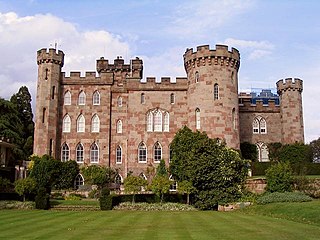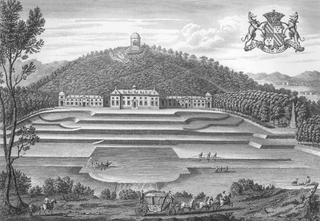

Haremere Hall is a Grade I listed Jacobean building near Etchingham, East Sussex. [1]


Haremere Hall is a Grade I listed Jacobean building near Etchingham, East Sussex. [1]
The hall is approximately 11,000-square-foot (1,000 m2) in size and sited in an 84-acre (34 ha) grounds. It is around 12 miles north of Hastings and the grounds overlook the River Rother. [1]
There has been a dwelling on the site of what is now Haremere Hall since the 12th century. The current building dates from the early 1600s. James Temple, one of the judges at the trial and subsequent execution of King Charles I, resided in the hall in the 1620s. By the end of the century, it had been occupied by the Busbridge family, relations of the Temples by marriage. [1]
John Lade, friend of the Prince Regent regularly visited the hall in the 19th century. The hall was purchased by Miles Lampson, 1st Baron Killearn in 1957. Following his death, it was the home of his widow Jacqueline, the dowager Lady Killearn. [1]
The house became Grade I listed in 1961. [2] In 2011, aged 102, the dowager Lady Killearn attempted to put the property on the market for around £1.65 million but was prevented from doing so by her son, Victor. [3]

Blickling Hall is a Jacobean stately home situated in 5,000 acres of parkland in a loop of the River Bure, near the village of Blickling north of Aylsham in Norfolk, England. The mansion was built on the ruins of a Tudor building for Sir Henry Hobart from 1616 and designed by Robert Lyminge. The library at Blickling Hall contains one of the most historically significant collections of manuscripts and books in England, containing an estimated 13,000 to 14,000 volumes. The core collection was formed by Sir Richard Ellys. The property passed into the care of the National Trust in 1940.

Temple Newsam is a Tudor-Jacobean house in Leeds, West Yorkshire, England, with grounds landscaped by Capability Brown.

Miles Wedderburn Lampson, 1st Baron Killearn, was a British diplomat.

Weston Park is a country house in Weston-under-Lizard, Staffordshire, England, set in more than 1,000 acres (400 ha) of park landscaped by Capability Brown. The park is located 10 miles (16 km) north-west of Wolverhampton, and 8 miles (13 km) north-east of Telford, close to the border with Shropshire. The 17th-century Hall is a Grade I listed building and several other features of the estate, such as the Orangery and the Stable block, are separately listed as Grade II.

Hurst Green is a village and civil parish in the Rother district of East Sussex, England, and is located south of the East Sussex / Kent border at Flimwell.
Etchingham is a village and civil parish in the Rother district of East Sussex in southern England. The village is located approximately 15 miles (24 km) southeast of Royal Tunbridge Wells in Kent and 13 miles (21 km) northwest of Hastings, on the A265, half a mile west of its junction with the A21.

Hovingham Hall is a country house built in the Palladian style in the village of Hovingham, North Yorkshire, England. It has been the seat of the Worsley family and the childhood home of the Duchess of Kent. It was built in the 18th century on a site the Worsleys have occupied since the 16th century.

Bruce Castle is a Grade I listed 16th-century manor house in Lordship Lane, Tottenham, London. It is named after the House of Bruce who formerly owned the land on which it is built. Believed to stand on the site of an earlier building, about which little is known, the current house is one of the oldest surviving English brick houses. It was remodelled in the 17th, 18th and 19th centuries.

Bramshill House, in Bramshill, northeast Hampshire, England, is one of the largest and most important Jacobean prodigy house mansions in England. It was built in the early 17th century by the 11th Baron Zouche of Harringworth but was partly destroyed by fire a few years later. The design shows the influence of the Italian Renaissance, which became popular in England during the late 16th century. The house was designated a Grade I listed building in 1952.

Whalley Abbey is a former Cistercian abbey in Whalley, Lancashire, England. After the dissolution of the monasteries, the abbey was largely demolished and a country house was built on the site. In the 20th century the house was modified and it is now the Retreat and Conference House of the Diocese of Blackburn of the Church of England. The ruins of the abbey are recorded in the National Heritage List for England as a designated Grade I listed building, and are a Scheduled Ancient Monument.

Kneller Hall is a Grade II listed mansion in Whitton, in the London Borough of Richmond upon Thames. It housed the Royal Military School of Music, training musicians for the British Army, which acquired the building in the mid-19th century. It was also home to the school's Museum of Army Music. The Army vacated the site on 31 August 2021.
The Headstone Museum, also known as the Harrow Museum, is the local history museum for the London Borough of Harrow in England.

Cholmondeley Castle is a country house in the civil parish of Cholmondeley, Cheshire, England. Together with its adjacent formal gardens, it is surrounded by parkland. The site of the house has been a seat of the Cholmondeley family since the 12th century. The present house replaced a timber-framed hall nearby. It was built at the start of the 19th century for George Cholmondeley, 1st Marquess of Cholmondeley, who designed most of it himself in the form of a crenellated castle. After the death of the Marquess, the house was extended to designs by Robert Smirke to produce the building in its present form. The house is designated by English Heritage as a Grade II* listed building.

Thorndon Hall is a Georgian Palladian country house within Thorndon Park, Ingrave, Essex, England, approximately two miles south of Brentwood and 25 miles (40 km) from central London.

Moor Park, Farnham, Surrey, England is a listed building and 60 acres (0.24 km2) of riverside grounds, in the former chapelry of Compton. The grounds formerly extended to Mother Ludlam's Cave, a cave entrenched in local folklore which faces across the Wey to the ruins of Waverley Abbey.

Stagenhoe is a Grade II listed stately home and surrounding gardens located in the village of St Paul's Walden in Hertfordshire. It is approximately 6 miles (10 km) south of Hitchin. It was the family seat of the Earl of Caithness. Socialite Lady Euphemia Sinclair spent her childhood there and became a friend of Queen Elizabeth the Queen Mother, whose family were neighbours.

Heveningham Hall is a Grade I listed building in Heveningham, Suffolk. The first house on the site was built for the politician and regicide William Heveningham in 1658. The present house, dating from 1778 to 1780, was designed by Sir Robert Taylor for Sir Gerald Vanneck, 2nd Baronet with interiors by James Wyatt. The hall remained in the Vanneck family until 1981.

Castle Hill in the parish of Filleigh in North Devon, is an early Neo-Palladian country house situated 3 miles north-west of South Molton and 8 mi (13 km) south-east of Barnstaple. It was built in 1730 by Hugh Fortescue, 14th Baron Clinton (1696–1751), who was later created in 1751 1st Baron Fortescue and 1st Earl of Clinton, the son of Hugh Fortescue, lord of the manor of Filleigh, Weare Giffard, etc., whose family is earliest recorded as residing in the 12th century at the manor of Whympston in the parish of Modbury in South Devon. The Fortescue family became major land owners, influential in British and West Country history. Castle Hill is a rare example in Devon of an 18th-century country mansion "on the grand scale".

The Old Palace, also referred to as the Archbishop's Palace, is a historic building situated within the precincts of Canterbury Cathedral. It is the main residence of the Archbishop of Canterbury when in Canterbury.

Moseley Hall is a Grade II listed 18th-century country house which was situated in parkland in Moseley, Birmingham. The hall itself is now part of Moseley Hall Hospital and much of the surrounding estate has been developed for roads and housing.
Coordinates: 51°00′46″N0°27′14″E / 51.01279°N 0.45391°E